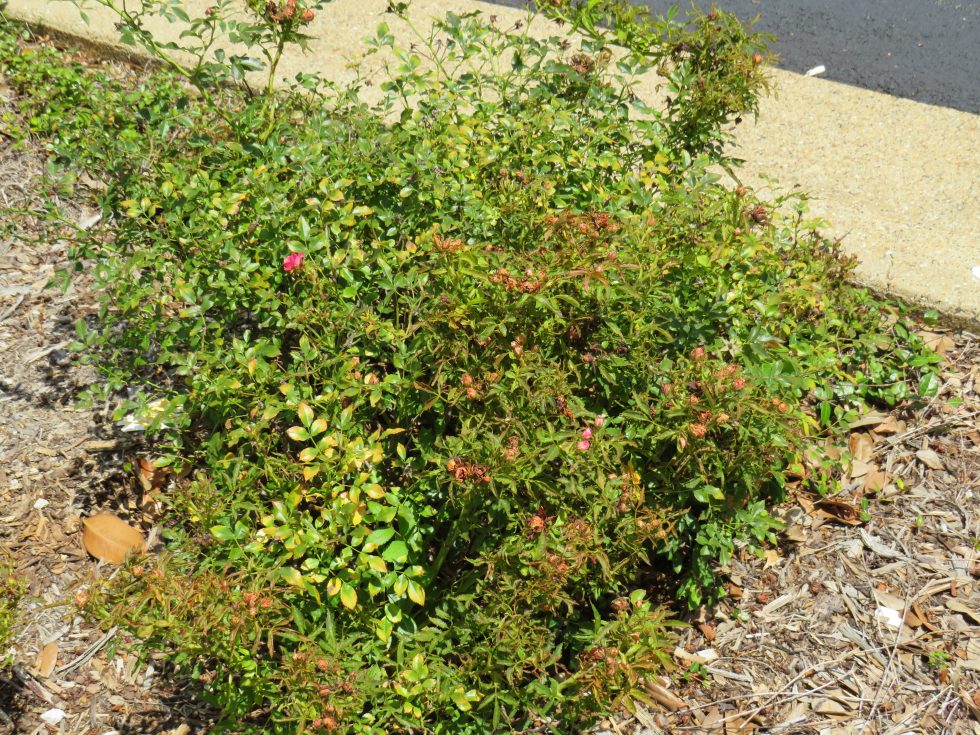
This year, two large public rose plantings in Tyler have been observed with rose rosette disease. One was at Broadway and the Loop, and the other on Roseland Boulevard just off Broadway. Every infected rose must be removed and destroyed immediately to prevent the disease from spreading throughout our home landscapes and public gardens. Tyler is known as the “Rose Capital of America,” so not growing roses isn’t an option. That’s why it is critical to recognize this devastating virus and learn how to respond when symptoms appear.
The symptoms of rose rosette are distinctive. The most obvious sign is a bizarre, densely clustered growth at the ends of branches known as a “witches’ broom.” These shoots often display an unusual red-orange color and an excessive number of thorns. However, color alone isn’t conclusive since many roses naturally produce reddish new growth. Infected plants often look like they’ve been hit with a broadleaf herbicide. You might also notice flattened or unusually elongated stems, distorted leaves, and rampant, erratic growth. In early stages, symptoms may appear on just a few shoots, but the disease spreads internally and eventually weakens or kills the plant over time.
Rose rosette virus spreads in two primary ways. In the garden, it is transmitted by a microscopic eriophyid mite that feeds on infected roses and then moves to healthy ones. These mites are so small that wind can carry them from plant to plant. To reduce the chances of spreading, avoid letting roses touch one another. The virus can also be transmitted through propagation. Any rose grown from cuttings or budwood taken from an infected plant will carry the disease since the virus lives within the plant’s tissue.
There is no cure. Pruning away the affected growth will not remove the virus, and applying pesticides or homemade remedies will not help. Once symptoms are visible, the disease has already spread throughout the plant.
The only solution is to remove and destroy the entire rose bush, including its roots as soon as symptoms are detected. Seal the infected plant in a trash bag and dispose of it with household waste or burn it if local regulations permit. Leaving infected roses in place puts all your other roses, and those across Tyler and East Texas, at risk. The virus is not soilborne, so once the diseased plants are gone, healthy roses can safely be replanted in the same location, although I’d suggest waiting until fall, winter, or spring when conditions are mild and moist.
If you suspect you have rose rosette, but are not certain, you may submit a sample to the Texas A&M AgriLife Extension Plant Disease Diagnostic Laboratory in College Station. Instructions and submission forms are available online at plantclinic.tamu.edu. There is a fee for diagnostic testing.
Greg Grant is the Smith County horticulturist and Master Gardener coordinator for the Texas A&M AgriLife Extension Service. He is the author of Texas Fruit and Vegetable Gardening, Texas Home Landscaping, Heirloom Gardening in the South, and The Rose Rustlers. You can read his “Greg’s Ramblings” blog at arborgate.com, his “In Greg’s Garden” column in Texas Gardener magazine at texasgardener.com or follow him on Facebook at “Greg Grant Gardens.” More science-based lawn and garden information from the Texas A&M AgriLife Extension Service is available at aggieturf.tamu.edu and aggie-horticulture.tamu.edu.
Image caption: Roses with rose rosette must be destroyed to prevent the disease from spreading to other roses.
Greg Grant, Ph.D.
County Extension Agent-Horticulture
Smith County
Texas A&M AgriLife Extension Service
1517 West Front St., Suite 116
Tyler, Texas 75702
903-590-2980
smith.agrilife.org
Facebook: “Greg Grant Gardens” & “Rebel Eloy Emanis Wildlife Sanctuary”
Blog: arborgate.com “Greg’s Ramblings”

